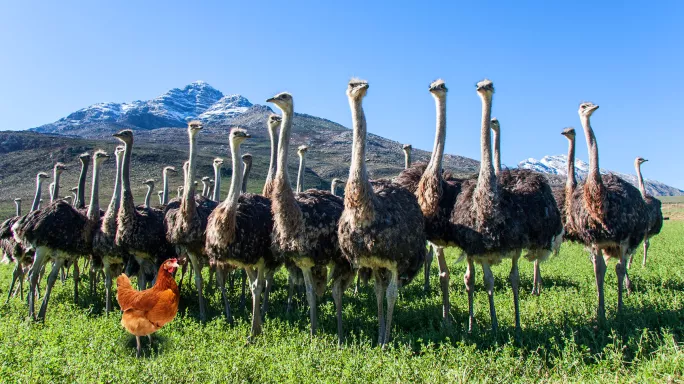Small schools are on the brink. Are MATs the answer?

“I unlock and lock up each day, cut the grass, clean the classrooms, do lunch duty, gate duty, lots of DIY, drive the minibus and even feed the school animals.”
Matt Jessop, headteacher of the 100-pupil Crosthwaite Church of England Primary School in Cumbria, is reflecting on the experience of being a small-school headteacher.
There are just over 2,000 primary schools with 100 or fewer pupils in England. With such low pupil numbers, these schools operate on razor-thin budgets - and things are likely to get harder: many will be hit by a declining birth rate that will hit pupil admission number income hard.
“Some small primary schools are barely financially sustainable as it is and any loss in pupil numbers is virtually impossible to absorb,” noted Geoff Barton, general secretary of the Association of School and College Leaders, recently.
Growing stronger
Given this situation, it seems many small schools are seeking refuge in multi-academy trusts (MATs), with data from the National Foundation for Educational Research (NFER) shared with Tes showing that of all schools to join a trust in 2021-22, 15 per cent were primaries with 100 or fewer pupils - the largest growth in six years.
Leora Cruddas, CEO of the Confederation of School Trusts, says it shows these settings are recognising the benefits of being in a trust: “Small schools can benefit perhaps more than most…by drawing on the wider talent and resources a larger organisation can support.”
Sue Parker, director of education at Diocese of Worcester Multi Academy Trust, formed of 16 schools (10 of which have fewer than 150 pupils, including one with 84 and one with just 66), says this was her thinking when she led her small school into the trust.
“I was increasingly isolated because although I had headteacher colleagues to talk to and we had a strong informal group, in terms of real support from the local authority, there wasn’t any,” she says.
For example, she says that the local authority would send a school improvement adviser once per year, but in the MAT someone will visit every half term, while there is also support from the centre in terms of finance, budgeting, HR and curriculum.
Another leader who has seen these benefits is Kerry McEwan, headteacher of Larkspur Primary School in Ware, Hertfordshire, which has just over 100 pupils and is part of the Ivy Learning Trust.
“It’s very helpful having other leaders in the trust you can talk to because leadership can be very lonely. It also means you can ask about initiatives or schemes of work and the impact they had,” she says.
She also notes that having access to a wider pool of staff can be hugely beneficial: “When you’re such a small set of people, if you lose somebody that can be quite detrimental to the running of the school, so we have seconded people from another school.”
Unaddressed concerns
However, despite these benefits and growth in small schools joining MATs, many are unconvinced. The NFER data also shows that 66 per cent of primary schools with fewer than 100 pupils are still in a local authority - the largest of any group yet to academise.
Jessop is one of those, saying he looked at joining a MAT but was wary of being run by individuals “based elsewhere in the county or even country” and the top-slice financial model (based at 2-3 per cent of budget) operated by the MAT he spoke to.
He adds that the idea staff could be seconded or asked to move between schools was also a concern: “Teachers didn’t want to move,” he says.
‘Staff have access to all sorts of CPD that we wouldn’t be able to afford or organise otherwise’
Julie Kelly, headteacher liaison officer for the National Association of Small Schools and head at a small village school in Hampshire, says these concerns are common among many small school leaders who want to “feel secure and remain at the heart of their community”.
Cruddas says she understands “[small school] heads and governors can be nervous about losing some of the very personal elements that can make them special”, and so trusts must be mindful of what these schools see as “crucial and non-negotiable for their children and community”.
However, she urges that small school heads and governors should not see a trust as an “enemy” and instead have an open mind when looking at a move to a trust.
“One of the things we always encourage school leaders to do when thinking about joining a trust is to discuss what they want to get from a trust and to be realistic that some things will change - often for the better,” she says.
‘Doing nothing is not an option’
It’s a message Nigel Genders, chief education officer of the Church of England, makes too - although somewhat more directly: “Doing nothing is not an option,” he tells Tes.
This is an issue especially pertinent to the CofE because a large number of its 4,600 schools are rural small schools, and Genders knows the pressures they face well.
“Historically, most governing bodies would have taken the view: ‘We just want to remain a single school with our own governing body and our own headteacher’,” he says. “What we’re saying is: that’s not a sustainable option - those schools can’t survive because the budget doesn’t stack up.”

That’s why the Church has long advocated for schools to move into some form of partnership with other schools - whether in trusts or federations. Many have heeded this call, with 1,535 CofE academies formed by its schools, including 254 MATs with CofE articles - making them the largest provider of trusts in the country.
One school leader who has been through this journey is Suki Pascoe, executive headteacher of two schools in the Diocese of Gloucester Academies Trust (DGAT). Originally, she was head of one non-MAT school, Bibury Primary, and admits academisation was “scary” for all concerned.
“It was 2014 when I took over and that was about the time when people were thinking about academisation and governors were really reticent,” she says.
Seeing the benefits from both sides
However, she was soon asked to become the executive head of North Cerney Primary Academy - a school already part of DGAT - as well, and so got to see life in an academised school.
“I could see the benefits it offered and because I had quite strong relationships in the school [Bibury], they trusted my judgement on that,” she says.
Bibury joined the trust a few years later and Pascoe says the schools are both in a much stronger position now: “Splitting my salary in half makes a massive difference to the budget and staff have access to all sorts of CPD that we wouldn’t be able to afford or organise otherwise.”
Genders cites the Diocese of Norwich Education and Academies Trust, which has nearly 40 small schools, as another example of how budgets can go further together: “They can share special educational needs and disabilities provision across a group of schools and they can share specialist teachers across a group of schools.”
Financial concerns
While such insights and economic warnings are clearly swaying growing numbers of small schools and will likely do the same for others, there is another group that may need convincing, too: the CEOs of MATs that these small schools may wish to join.
“I think there’s something really lovely about small schools - the parents, the community, the choice they provide - but they’re not very attractive for MATs,” admits Matthew Kleiner-Mann, CEO of Ivy Learning Trust, a MAT of 14 schools.
That doesn’t mean he is against taking on small schools - far from it. Larkspur, mentioned earlier, is one of its schools and has moved from an Ofsted rating of “special measures” to “good” since joining.
However, he notes that for trusts with a top-slice model, such as his own, small schools add little to their budgets but eat up a lot of time, effort and resources. “We’ve invested in our small schools probably more than some of our [larger schools],” he adds.
Lee Mason-Ellis, CEO of The Pioneer Academy, shares a similar view: “Taking on small schools is an increasingly difficult challenge for all trusts due to the impact of unfunded teacher salary increases and the current economic climate.”

Meanwhile, Sir David Carter, former national schools commissioner, tells Tes that discussions with CEOs about small schools’ finances in MATs used to come up “all the time” during his time in post: “No trust is going to take one small school of 60 kids. They would want to take a cluster.”
Genders acknowledges the point: “Each time you look at an individual school, you have to ask all those questions about what the impact on the trust is. And if it’s a school with 300 pupils, that’s going to be great - but if it was a school with 50 pupils, you’d be thinking, ‘How do we sustain that within the trust?’”
As such, he agrees that creating clusters of schools to join MATs has logic. But he adds that because “not many trusts have articles that enable them to be ‘mixed’ MATs” - ie, to have both church and non-church schools - it is not as simple as it sounds.
Genders says he has worked with some trusts that have changed their articles to overcome this issue: “I was talking to a trust that knew they wanted to grow, and because some of their surrounding schools were CofE schools they asked us, ‘how can we change our articles to take on those schools?’” he says. “And that’s what they’ve done: moved from a community-based set of articles to a church model article trust.”
‘A moral imperative’
Even without taking clusters, some CEOs also feel that, despite the financial challenges, there is - as Mason-Ellis puts it - a “moral imperative for us to take on small schools”.
Dartmoor Multi-Academy Trust CEO Dan Morrow discussed the issue in a Tes Magazine Leadership Forum webinar earlier this year, and said he also feels there is a “moral and ethical responsibility” to ensure small schools survive in MATs.
“We have one school with nine pupils that is so vitally important to its local community, but would not be sustained without being part of a wider [trust],” he said.
But even when there is willingness on all sides, there is still a big barrier to something actually happening: matching small schools with trusts.
“If I have to go out there and find 10 schools and talk to each one about who we are and what we do and what a MAT is, and so on, I’ll lose the will to live,” admits Kleiner-Mann at Ivy Learning Trust.
He says the government needs to get better at brokering events: “Perhaps there needs to be some sort of speed dating system for small schools and MATs, where there is a presentation about what a trust is, delivered by some neutral third party in one room, and then the schools go into another room and meet lots of trusts and see who is the best fit.”
‘Perhaps there needs to be some sort of speed dating system for small schools and MATs’
While not quite advocating a speed dating set-up, Sir David agrees that, if in post again, this is something he would try to create.
“I would get the dioceses and local authority together with a group of MATs that covered a small part of the region and work with them to decide how we could move forward,” he says.
A spokesperson for the David Ross Education Trust agreed that the Department for Education needs to be more proactive in this area so larger trusts can provide “safe havens” for small schools.
“To secure the future of these schools, we need to think pragmatically about this challenge - clustering smaller primaries or looking at grouping them with larger primaries or secondary schools when the DfE is speaking to academy trusts about schools potentially joining a trust,” they said. “These things would make a real difference when trusts consider their own due diligence.”
More agency
Genders says that, for CofE schools, the situation is better because the diocese will have oversight of existing trusts with faith articles that could make a suitable fit.
“If you’re thinking ‘who can I join’, then a conversation with the diocese will help determine whether there’s already an existing trust that you can join,” he explains.
“I sometimes hear small community schools rue the fact they haven’t got an equivalent to the diocese that can help them through that maze.”
However, with 3,000-plus CofE schools yet to join or form a MAT, this oversight of its schools is only useful to a point - not least because Genders says current legislation makes it hard for the church to form its own MATs.
“The law says that if you’re running a primary school as the chair of governors, it is your decision which MAT you join,” notes Genders.
That makes it a time-consuming affair, he says, and uses the Canterbury diocese and its 104 schools and academies as an example of what could be achieved with more agency.
“What every director of education [in a diocese] is thinking is: ‘I’ve got these 104 schools and we are on a route to full academisation, so how do I find the right combination of MATs that will cater for all of those schools?’” he says.
“It’s not about picking off one or two and saying, ‘Well, this school needs to be an academy’ - it’s about sitting down with a map and saying: ‘OK, I’ve got 104 schools…I probably need four MATs that could cater for all of those…with 25 schools to a MAT.’ But the system doesn’t work like that.”
Can the government do more?
The now-defunct Schools Bill was attempting to rectify some of this, which Genders says showed the DfE was aware that “if they wanted to complete the system”, they had to “remove the barriers that prevented the church from really embracing the full academisation route”.
The DfE told Tes that it is aware of the challenges small schools face and is working to create conditions that enable them to find and join MATs to enable their long-term future.
“High-quality MATs support schools of all sizes to share resources, staff and expertise, which is why we want all schools, big and small, to be part of one,” a spokesperson said.
They added: “We recently published commissioning guidance, which sets out how regional directors take a strategic approach to commissioning, encouraging trusts to form hubs or clusters of schools so that no small school is left out.
“We have also committed £86 million of Trust Capacity Funding to help trusts build their capacity and we have also launched the Trust Establishment and Growth, a competitive grant available to trusts, schools, dioceses and other organisations looking to establish a new MAT.”
But as laid out in this article, legal hoops and finances are not the only barriers to be overcome: some schools simply don’t want to join a trust.
“Why would a school as successful as ours cede control of staffing and other elements to a board of trustees?” says Jessop, who adds that, if that happened, “I wouldn’t stay”.
And Kelly says that seeing a MAT as the saviour of small schools is the wrong way of looking at it - small schools play a vital role for communities and what we need most of all is to find a way of saving them all, regardless of whether they are in a MAT.
“There needs to be a national initiative to ensure small schools are supported and thrive in whatever system they may join,” she concludes.
Dan Worth is senior editor at Tes
You need a Tes subscription to read this article
Subscribe now to read this article and get other subscriber-only content:
- Unlimited access to all Tes magazine content
- Exclusive subscriber-only stories
- Award-winning email newsletters
Already a subscriber? Log in
You need a subscription to read this article
Subscribe now to read this article and get other subscriber-only content, including:
- Unlimited access to all Tes magazine content
- Exclusive subscriber-only stories
- Award-winning email newsletters



